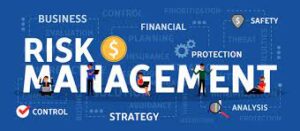Back to: Store Management SS 2
Welcome to today’s class!!
We are thrilled to have you in our class!!
In today’s Store Management class, we will be learning about Meaning of Risk Management
Meaning of Risk Management

When an entity makes an investment decision, it exposes itself to a number of financial risks. The level of such risks depends on the type of financial instrument. These financial risks might be in the form of high inflation, volatility in capital markets, recession, bankruptcy, and so on.
Risk management refers to the practice of identifying potential risks in advance, analyzing them and taking precautionary steps to reduce the risk.
So, in order to minimize and control the exposure of investment to such risks, fund managers and investors practice risk management. Different levels of risk come attached with different categories of asset classes.
To reduce risk, an organization needs to apply resources to minimize, monitor and control the impact of negative events while maximizing positive events. A consistent, systemic and integrated approach to risk management can help determine how best to identify, manage and mitigate significant risks.
By focusing attention on risk and committing the necessary resources to control and mitigate risk, a business will protect itself from uncertainty, reduce costs and increase the likelihood of business continuity and success.
Three important steps of the risk management process are risk identification, risk analysis and assessment, and risk mitigation and monitoring.
- Risk Identification
Risk identification is the process of identifying and assessing threats to an organization, its operations and its workforce. For example, risk identification may include assessing Information Technology security threats such as malware and ransomware, accidents, natural disasters and other potentially harmful events that could disrupt business operations.
- Risk Analysis And Assessment
Risk analysis involves establishing the probability that a risk event might occur and the potential outcome of each event. Risk evaluation compares the magnitude of each risk and ranks them according to prominence and consequence.
- Risk Mitigation And Monitoring
Risk mitigation refers to the process of planning and developing methods and options to reduce threats to project objectives. A project team might implement risk mitigation strategies to identify, monitor and evaluate risks and consequences inherent to completing a specific project, such as new product creation. Risk mitigation also includes the actions put into place to deal with issues and effects of those issues regarding a project.
In summary, not giving due importance to risk management while making investment decisions might wreak havoc on investment in times of financial distress in an economy.
Evaluation
What is Risk Management?
Reading Assignment
Explain five implications of ignoring Risk Management
Weekend Assignment
Explain five advantages of Risk Management
We hope you enjoyed today’s class. In our next class, we will be talking about an introduction to the Imprest System.
Let us know your thoughts and questions in the comment section, and we will attend to them as fast as we can.
